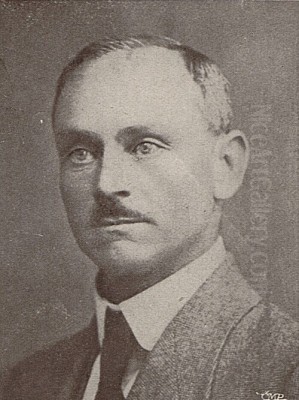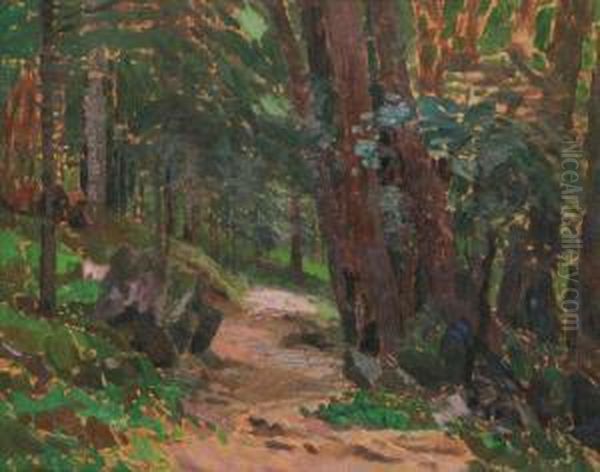
Roman Havelka stands as a notable figure in the landscape of Czech art history. A painter whose life spanned a period of significant artistic transformation, from the late 19th century into the mid-20th century, Havelka carved out a distinct niche for himself, particularly within the realm of landscape painting. His work reflects both the strong traditions of Czech art education and the burgeoning influence of modern European movements, most notably Impressionism. Understanding his background, artistic development, and contributions provides insight into the cultural milieu of Moravia and Bohemia during his lifetime.
Foundational Years and Artistic Education
Roman Havelka was born on April 30, 1877, in the town of Jemnice, located in what is now the Czech Republic. Much of his life and professional career unfolded in Hodonín, a town in the South Moravian Region, suggesting a deep connection to this part of the country, whose landscapes would feature prominently in his work. His artistic journey began with formal training, indicating a commitment to mastering the technical aspects of his craft from an early age.
The provided sources state he graduated from the "Malako University Art Academy." While the exact name might be a variation or slight misrepresentation, it points towards a significant institution, likely the prestigious Academy of Fine Arts in Prague (Akademie výtvarných umění v Praze), which was the premier art school in the region. His education was shaped by several influential professors who were prominent artists themselves. The records mention studies under Professor Liška (possibly Antonín Liška or another contemporary figure bearing the name), Professor Stibral, Professor Mařák (almost certainly Julius Mařák, a pivotal figure in Czech landscape painting), and Professor Rudolf Ottenfeld.

Studying under Julius Mařák, in particular, would have been formative. Mařák headed a highly influential landscape painting studio at the Prague Academy from 1887 to 1899. His school emphasized realism but also fostered an appreciation for capturing atmospheric effects and the specific character of the Czech landscape, laying groundwork that many of his students, including figures like Antonín Slavíček, František Kaván, and Alois Kalvoda, would later develop towards Impressionism and other modern styles. Havelka's own stylistic inclinations seem to stem directly from this educational lineage.
Artistic Style: Impressionism and Landscape
Havelka's artistic output is strongly characterized by his dedication to landscape painting. His style is described as being deeply influenced by Impressionism. This suggests a focus on capturing the fleeting effects of light and atmosphere, an interest in plein air (outdoor) painting, and the use of visible brushstrokes and a vibrant palette. The sources note his works feature "vivid colors" and "modern Impressionist features," positioning him within the wave of artists who adapted French Impressionist techniques to a Central European context.
He is noted for creating large-scale landscape paintings, indicating ambition in his compositions and a desire to fully immerse the viewer in the natural scenes he depicted. His connection to the Mařák school ("Mařákovský") suggests a foundation in realistic depiction combined with a lyrical or romantic sensibility towards nature, which evolved under the influence of Impressionism. The mention of "Moravská kresba" (Moravian drawing/landscape school) further roots his work in a specific regional tradition, likely focusing on the unique topography and rural life of Moravia.
His paintings aimed to convey a profound understanding of nature, moving beyond mere topographical accuracy to capture the mood and essence of the landscapes he observed. This blend of inherited tradition from masters like Mařák and the adoption of contemporary Impressionist methods defined his unique artistic voice.
Representative Works and Attribution Complexities
Several works are attributed to Roman Havelka in the source materials, showcasing his focus on landscape and potentially other themes. Mentioned specifically are Oil Field, dated 1930, and Forest Stream, dated 1877. Another work titled Les toundra (Forest Tundra) is cited as an example of his style blending Mařák's influence with modern Impressionism. Additionally, works titled Solferino's Falling Sword and Mostar Bridge are mentioned in connection with his illustrative work or landscape painting, though these titles seem somewhat atypical for his known focus.
However, the provided information presents significant confusion regarding the attribution and dating of some key titles. For the painting Oil Field, the text initially attributes a work of this title dated 1930 to Havelka. Yet, in another section, it discusses an oil painting titled I Love Oil Field created in 1979 by the Chinese artist Gao Xiaohua, which won an award. This strongly suggests a conflation or error in the source data regarding an "Oil Field" painting associated with Havelka.
Similarly, Forest Stream is first listed as a Havelka work from 1877 (which would be remarkably early, created when he was born). Later, the text provides conflicting information, attributing a work titled Forest Stream dated 1871 to the Finnish painter Fanny Churberg, and another Forest Stream dated circa 1660 to the Dutch master Jacob van Ruisdael. This indicates that the title Forest Stream is common, and the attribution to Havelka with the 1877 date in the source material is highly questionable or likely incorrect.
Despite these specific attribution issues highlighted within the source text itself, Havelka's reputation rests firmly on his body of landscape work, which was evidently substantial enough to earn him recognition within the Czech art community. His paintings capturing the essence of the Moravian and Czech countryside remain his primary legacy.
Role in the Czech Art Community
Roman Havelka was not merely a solitary painter; he was an active participant in the Czech art world. He was a member of the Sdružení výtvarných umělců moravských (Association of Moravian Fine Artists, SVUM), a significant regional organization for artists. His involvement went beyond simple membership; the sources state he served as the Chairman of this association, placing him in a position of leadership and influence within the Moravian art scene.
His connection to SVUM is further evidenced by his association with other member artists, such as Oldřich Kobienda and Oldřich Lasák, whose names appear alongside his in the association's records. This indicates collegial relationships and shared activities within the organized art community of Moravia. His participation suggests a commitment to promoting the arts in the region and fostering a supportive environment for fellow artists.
Furthermore, Havelka's influence extended to the next generation through teaching. The sources mention Lidija Lišková and a certain Stibral (possibly the same Professor Stibral mentioned as one of his teachers, or another individual) as his students, likely during his time associated with the Prague Academy or perhaps later in his career. This role as an educator underscores his standing and contribution to the continuity of Czech artistic traditions.
He was also connected to the art discourse of his time through publications. His name is associated with the magazine Moravských umělů (likely Salon Moravských umělců or a similar title), which was edited by the artist Jano Köhler around 1924-1925. This suggests Havelka's work or activities were featured or discussed within contemporary art journals, contributing to the broader cultural conversation. His work was also reportedly featured in publications related to the historic Jaroměřice nad Rokytnou castle.
Reported Achievements and Experiences: A Note on Conflation
The source materials, while providing core biographical details about Roman Havelka the painter, also present a confusing mix of achievements and life events attributed to the name "Roman Havelka" that appear to belong to other prominent Czech individuals with the same surname. It is crucial to report this information as presented in the sources, while acknowledging the high probability of conflation.
According to these sources, "Roman Havelka" is credited with significant contributions beyond painting. He is mentioned as a co-author, alongside Miloš Havelka (a known Czech historian and philosopher), of the book Faith, Culture and Society: Czech Religious Culture in the 19th and 20th Centuries. He is also credited with editing the volume Debate on the Meaning of Czech History and publishing articles in academic journals, activities strongly associated with Miloš Havelka, not the painter.
Furthermore, the sources attribute a career in music composition to "Roman Havelka." This includes composing symphonic and orchestral works like Poemia and Percussionata, creating numerous film scores (over 70 features and 150 shorts), and experiencing a profound religious conversion around 1977, turning from atheism to Christianity and reflecting this in works like Profetéa and Parennezy. These achievements align perfectly with the biography of Svatopluk Havelka (1925–2009), a major Czech composer, not Roman Havelka the painter (1877-1950).
The text also mentions anecdotes related to Karel "Kouroc" Havelka (b. 1951), a musician with a dramatic life involving political dissent and imprisonment, explicitly stating this is a different person. However, the conflation of the painter with the historian Miloš Havelka and the composer Svatopluk Havelka within the description of achievements and experiences seems evident in the source material itself. While Roman Havelka the painter achieved recognition in his own field, these specific accomplishments in history, philosophy, and music belong to other notable Czech figures.
Legacy and Collections
Roman Havelka passed away on June 20, 1950. His legacy endures primarily through his landscape paintings, which capture the beauty and specific character of the Czech, particularly Moravian, countryside. His work represents an important strand of Czech art that absorbed the lessons of late 19th-century realism, particularly through the Mařák school, and integrated them with the modern sensibilities of Impressionism.
His paintings are held in public collections, ensuring their preservation and accessibility. The sources mention his work is part of the collection at the Vysočina Regional Gallery (Oblastní galerie Vysočiny), located in Jihlava. The presence of his work in such institutions confirms his status as a recognized artist within the Czech national heritage.
Though perhaps overshadowed internationally by some of his contemporaries from Prague's bustling art scene, Roman Havelka remains a significant regional painter. His dedication to landscape, his active role in the Moravian art community through SVUM, and his contribution to the lineage of Czech painting stemming from the influential Mařák school solidify his place in Czech art history. His work offers valuable insight into the evolution of landscape painting in Central Europe during a period of rich artistic development. He remains appreciated for his ability to convey the atmosphere and unique identity of the landscapes he knew and loved.